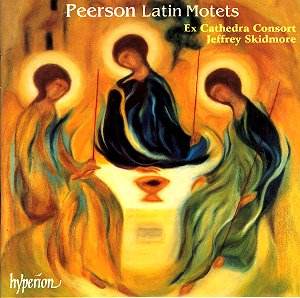If you know anything about Martin Peerson at all then
it may be through the short keyboard pieces which are found
in the ‘Fitzwilliam Virginal Book’ (c.1610). Pieces like ‘The
Fall of a leaf’ and the longer ‘Pipers Pavan’. These are his
earliest known compositions and are really rather like GCSE
compositions in comparison with his later music, especially
these motets.
A CD of Peerson’s music appeared on the now defunct Collins
Classics label in 1994, a rather weak affair in many ways, but
it did give an overall view of his work for the period c.1610
until the 1630s. It may be useful to briefly look at his other
early works.
In 1614 he produced a collection entitled ‘Teares and
Lamentations’, settings of verses by Sir William Leighton written
whilst he was in prison. That was followed, two years later,
by ‘Tristiae Remedium’, texts assembled by the Reverend Thomas
Myriell, mainly using psalm texts in the English language. By
now Peerson was an established composer.
In 1620 his collection ‘Private Musicke’ appeared (this
is the title of the Collins CD collection), pieces which included
madrigals and consort songs. Some metrical psalm tunes were
published in 1621, and then a group of ‘Motets or Grave Chamber
Musique’ came out almost ten years later, with texts, again
in English, but with the then fashionable keyboard continuo.
His style moved on and despite fashionable developments
showed significant signs of being rooted in Renaissance polyphony.
However he could also be forward-looking in his often daring
use of chromaticism especially seen in word-painting. This then
is the point at which we come in, as it were, with the present
CD.
These fifteen Latin motets, here being heard and recorded
for the first time “survives in a single copy”, to quote the
excellent booklet notes by Richard Rastell. It was completed
around 1655-6 “but it had been started much earlier, so that
Peerson’s motets could have been composed originally in the
1630s. The copy originally consisted of the five part-books
but the Cantus book is now lost; the remaining four books give
only an incomplete texture, and the top voice must be reconstructed”.
Richard Rastell has done just that and Antico Edition now publish
all fifteen complete motets.
It was an excellent idea by Jeffrey Skidmore to record
the motets in their manuscript order as there is a distinct
pattern to them, both harmonically and texturally. The notes
again are worth quoting “Motets 1-5 have G as a final ... Motets
6-9 have A as a final; they treat Christ’s death on the cross
as man’s way to salvation. The last and largest group, motets
10-15, again have G as the final. The group begins with a joyous
reminder to send his Comforter and then sets out the intellectual
argument for Christ as Redeemer”. So after the first five motets,
including two double motets based on Psalms, we embark on the
Passiontide ones culminating in ‘O Rex Gloriae’, a motet for
Ascension. Then follows a Magnificat-based text, then two (of
six) texts which are unique to the manuscript. Finally there
is a magnificent double motet finding mankind ‘being glad in
the Lord’. This has a glorious ending in triple time, the only
example in the entire set.
The style of the music is deeply conservative for its
period but not unlike Thomas Tomkins. I am especially reminded
of this with Peerson’s quite modern use of chromaticism such
as passages like ‘et fac ut tibi propter’, in motet one. This
also contains very expressive suspensions on the word ‘miserere’.
Word painting is far more vivid than in say Byrd or Gibbons.
There are many examples but I was especially struck in motet
3 ‘Pater fili paraclete’ with the passage (in translation) ‘illumination,
fount, river, spring, from whom, through whom ...’. Rather like
the Portuguese composers of the 17th century, this
conservatism is also reflected in the almost continuous polyphonic
nature and imitative textures of the musical language which
can also be intensely expressive as in motet twelve ‘O domine
jesu Christe’ with its plea ‘ spare sinners, justify the faithful,
have mercy and be gracious’.
The church where the recording was made is, I think,
new to me, yet I must say that it has an excellent acoustic.
On thing which marks off this recording for me is the wonderfully
wide spacing of the voices, yet there is a real sense of an
intimate atmosphere of a Roman Catholic family chapel. It must
be said however that there is evidence that, as the composer
worked at Westminster Abbey at the latter end of his life, these
motets might well have been performed there. Interestingly the
Abbey is, of course, a Royal peculiar and was answerable only
to the Crown and at this time it was the open-minded Charles
1st.
Obviously the music is unknown but it does seem that
Ex Cathedra have spent much time and some considerable effort
on fully realizing these pieces. These are not read-throughs
but proper performances sung with understanding and commitment.
All texts are given in Latin with sound and sensible
translations.
A unique disc which is well worth investigating.
Gary
Higginson

![]() Ex Cathedra/Jeffrey Skidmore
Ex Cathedra/Jeffrey Skidmore![]() HYPERION
CDA 67490 [65.33]
HYPERION
CDA 67490 [65.33]![]() for details
for details![]()






